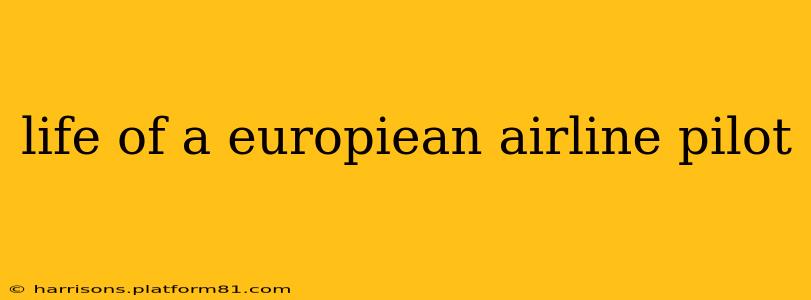The life of a European airline pilot is a glamorous image often portrayed in movies and television. While the reality includes plenty of exciting moments and breathtaking views, it's a demanding career requiring dedication, precision, and a significant commitment to ongoing training and regulation. This detailed exploration delves into the realities, challenges, and rewards of this fascinating profession, addressing frequently asked questions along the way.
What is the typical day like for a European airline pilot?
A typical day for a European airline pilot is far from typical, varying greatly depending on the airline, aircraft type, and flight schedule. Short-haul flights might involve multiple rotations in a single day, with early morning departures and late-night arrivals. Long-haul flights, on the other hand, can see pilots away from home for several days at a time, with extensive rest periods factored into their schedules to comply with stringent flight time limitations (FTL). A "typical" day could involve pre-flight checks, briefing with the crew, executing the flight, post-flight debriefing, and completing necessary paperwork. Evenings might involve rest at a hotel (for long-haul) or time spent at home if based locally. The life is demanding, and requires adaptability and excellent time management skills.
How much do European airline pilots earn?
Pilot salaries in Europe vary significantly based on factors such as airline size, experience, aircraft type, and contractual agreements. Starting salaries for first officers (co-pilots) can be competitive, while experienced captains with seniority often earn substantial incomes. Benefits packages often include health insurance, pension schemes, and travel perks. While the potential for high earnings is a significant draw, it's crucial to remember that the career path involves substantial investment in training and licensing.
What are the working conditions like for European airline pilots?
Working conditions are a key element to consider. While the job offers significant personal and professional rewards, it's important to acknowledge the demanding nature of the work. Irregular hours, long periods away from home (especially for long-haul pilots), and the intense pressure of ensuring passenger safety can take a toll. Airlines are increasingly focusing on improving pilot well-being and reducing fatigue, but it remains a demanding occupation.
What qualifications are needed to become a European airline pilot?
Becoming a European airline pilot requires a substantial investment in education and training. This typically includes completing an integrated ATPL (Airline Transport Pilot Licence) program, which involves theoretical ground school and flight training, often spanning several years. Meeting strict medical standards is also essential. The specific requirements and pathways to becoming a pilot can vary slightly between European countries, but the overall commitment to training is consistent.
What are the career progression opportunities for European airline pilots?
Career progression typically involves progressing from First Officer to Captain, with opportunities to specialize in different aircraft types or move into management roles within the airline. Seniority plays a significant role in advancement, and pilots often accumulate years of experience before reaching the captaincy. International opportunities also exist, allowing pilots to work for airlines operating across Europe and beyond.
How does the job affect personal life?
The demanding nature of the job inevitably impacts personal life. Irregular working hours and extended periods away from home can strain relationships. Pilots often need to be highly organized and adaptable to manage their personal and professional lives effectively. Maintaining a healthy work-life balance is a continuous challenge, requiring careful planning and strong support networks.
Are there any downsides to being a European airline pilot?
While the job offers numerous advantages, several potential downsides exist. The demanding nature of the work, irregular hours, and time away from home are significant factors. Competition for pilot positions can be fierce, and economic downturns can impact job security within the airline industry. Furthermore, the constant pressure to maintain safety standards and adhere to strict regulations contributes to the high-stress nature of the role.
Conclusion:
The life of a European airline pilot is a challenging yet rewarding career. While the glamour associated with the profession is undeniable, the reality involves hard work, dedication, and significant training. The financial rewards, opportunities for travel and personal growth, and the unique responsibility of ensuring passenger safety make it a uniquely fulfilling vocation for those who are passionate about aviation and dedicated to mastering this complex and demanding profession.
